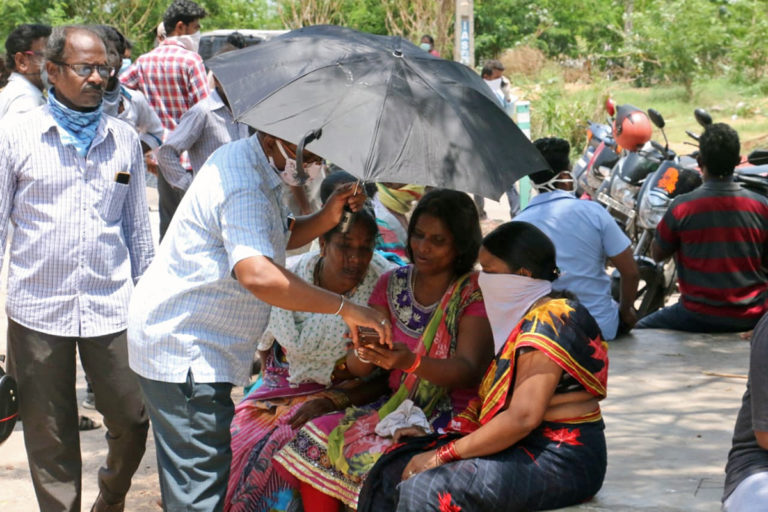
Pratap Singh Tomer is a retired serviceman living in the Ravi Nagar locality of Visakhapatnam, a port city in the state of Andhra Pradesh. In the wee hours on May 7, he was awoken by desperate honking of vehicles and shouts of baffled citizens in his colony.
There was a pungent smell of gas and some of the residents were experiencing dizziness. Tomer, who has years of experience working in LPG plants and is acquainted with gas leaks and rescue training, used his expertise and presence of mind to help others. “I thought that this could be a case of a gas leak from a nearby industrial plant. I knew that there is one big plant of LG Polymers towards the southern direction of our locality,” Tomer, who went to his house’s roof to check the wind direction using a flag, told Mongabay-India.
As soon as he ascertained that the wind direction is from the plant and suspected gas leak could be from the LG Polymers plant, he appealed to people in his area to rush towards the northeast to a plain ground to avert any damage. “Due to favourable wind direction and early evacuation many were able to save their lives,” Tomer said.
However, not all were lucky as many in the villages that are in close proximity to the industrial plant lost their lives. Most of the affected villages were within three kilometres radius of the plant. According to reports, at least 12 people, including two minors, living near the plant lost their lives while they were sleeping. Additionally, 32 animals (including cattle) were also killed.
Andhra Pradesh Director General of Police D. Goutam Sawang, in a press conference on May 7, said that 800 people were admitted to the hospital after the gas leak incident. Andhra Chief Minister Jagan Mohan Reddy has also announced a compensation of Rs. one crore (Rs. 10 million) for the family members of those who died due to the gas leak.
The people and animals died due to inhaling toxic styrene gas that leaked from the LG Polymers industrial plant situated in the R.R. Venkatapuram village, six kilometres away from the Visakhapatnam International Airport and around 10 kms away from the city’s main railway station. Styrene is an organic compound that is found in liquid form but vapourises at high temperatures. According to a statement LG Polymers, the gas leaked from one of the containers storing it. It happened after the plant was about to start operations after being closed for 43 days post the nationwide lockdown imposed to contain the spread of novel coronavirus disease (COVID-19) pandemic.
The preliminary findings of the Andhra Pradesh Forensic Science Laboratory have revealed that the accident was due to human error as the temperature of the storage tank containing styrene was not maintained below 20 degree Celsius.
LG Polymers is a subsidiary unit of LG Chemicals and part of South Korea’s LG Group. It had taken over the erstwhile Hindustan Polymers in 1997.
After the incident, several public health experts drew a comparison with the 1984 Bhopal gas tragedy. “Both the Bhopal gas tragedy and the Visakhapatnam (Vizag) gas leak occurred during the night and also when the plants were about to restart after some time gap. We need to learn a lot of things from such tragedies,” said Professor V. Ramana Dhara of the Indian Institute of Public Health, Hyderabad.
Dhara, who is also a member of the International Medical Commission on Bhopal, said a detailed analysis and a long term study is needed to reveal the long term effect of the gas on the exposed human population.

Some experts claimed that the gas leak is a clear case of human negligence. “Hazardous industries are vulnerable to mishaps and thus they need to follow standard safety procedures and do safety audits whenever they resume operations after a gap,” Sankar Prasad Pani, a lawyer with the National Green Tribunal (NGT), told Mongabay-India.
Identifying health hazards will take time
The health impact of styrene on humans differs on the duration of exposure. While acute symptoms were instantly shown by the exposed population, the long term effects of the exposure are yet to be identified.
The CSIR-NEERI (National Environmental Engineering Research Institute), Nagpur which conducted its preliminary assessment of the plant and nearby villages, has said that it will continue long term study of the area for assessing the effect of the gas on the environment. The team from the organisation has taken soil, water, and air samples for the study.
“We have taken the samples. Styrene usually becomes inert after long exposure to air. But it came in contact with the plants, soil, water and food and that could be toxic. We issued a public advisory asking people not to consume water from open surfaces and foods/vegetables that were exposed to the gas,” Rakesh Kumar, director of CSIR-NEERI, Nagpur told Mongabay-India. “This was our preliminary assessment. We will be conducting a long term study as well to analyse the long term effect of the gas on the local environment and population. The long term impact cannot be understood from a short term study.”
Oncologists highlight that styrene is a ‘possible carcinogen’ as per the World Health Organisation (WHO) affiliated International Agency for Research on Cancer. “The short term exposures have short term effects but the Andhra Medical College neurology department has now reported that many exposed population still after one week of the incident complain about guiltiness, which hints at neurological impact,” Raghunanda Rao, a veteran oncologist and founder of Homi Bhabha Cancer Hospital and Research Centre, Vizag, told Mongabay-India.
He noted that a long period of study is needed to assess if pregnant women and their embryos were affected due to the incident.
Rules were flouted from years
Although the South Korean subsidiary in their statement claimed to have been following international standards on safety, the accident has raised questions over lack of compliance to the Standard Operating Protocol (SOP), mismanagement in the handling of the hazardous chemical, lack of onsite and offsite emergency plans to control the after-effects of the accident.
But this is not the complete picture. According to the documents submitted by the company to the Union Ministry of Environment, Forest and Climate Change, the LG Polymers plant has been operating without a valid environment clearance under the provisions of Environment Impact Assessment (EIA) notification 2006. It only had consent for establishment and consent for operation from the Andhra Pradesh Pollution Control Board (APPCB).
The project had applied for environment clearance from the MoEFCC under the category of projects running in violation of the EIA notification. It was scheduled to be considered by an expert panel of the MoEFCC on May 18-19, 2020. The decision of the meeting of the expert panel is not public as yet.
“This was not the first such incident in Vizag. We have already seen 30-40 accidents in the past few years where people have lost their lives or suffered injuries. But as no promoter was strictly punished or erring government officials booked, the industrial accidents continue unabated,” EAS Sarma, an environmentalist from Vizag and a former secretary to the government of India, told Mongabay-India.
He criticised the APPCB for giving approval to the LG Polymers in an area having human habitations despite the lack of environmental clearance.
The MoEFCC’s attempts to regularise industries operating without environment clearance or in violation of the environmental regulations has been severely criticised by environmentalists and experts alike. The latest proposed overhaul of the draft EIA notification 2020 which would replace EIA 2006 notification has been under fire for proposing a mechanism to legitimise projects starting construction without a valid clearance.
Previously as well, in March 2017, the central government had come out with a notification that provided industrial projects that started construction, undertook expansion, or modernisation without prior environment clearance to regularise. Subsequently, in the last three years, hundreds of such projects have been considered for environment clearance.
The region has witnessed high growth of industries
Due to proximity with a mining region, a port and railway facilities, Visakhapatnam has emerged as an attractive destination for industries over the past few years. However, the city as well as Andhra Pradesh as a whole, has been a witness to several mishaps.
According to data provided by the Union Ministry of Labour and Employment to the Lok Sabha in parliament on March 16 earlier this year, Andhra Pradesh has seen a total of 383 deaths due to industrial mishaps in five years (till 2017) and a total of 1,047 injuries.
Reports also suggest that in Vizag city alone, in the last decade, a total of 54 people have lost their lives due to industrial accidents.
Though Andhra Pradesh’s Chief Minister Y.S. Jagan Mohan Reddy has stated that the company would be held responsible for the incident and action would be taken against it, experts believe that a lack of stringent action against the erring industries by the Andhra Pradesh government has encouraged such defaulting industries.
“There are several laws in hand to ensure compliance with safety standards but many industries don’t comply due to lack of physical verification. The environment ministry has several regional offices that can verify the compliance of laws but several times one single regional office caters to 6-7 states and it becomes a herculean task for them to verify the ground reality,” said Ramesh Agrawal, an environmentalist from Chhattisgarh told Mongabay-India.
He emphasised that the state pollution control boards are also mandated to verify compliance but in most cases, the statements and promises made by the industries on paper are treated at face value while they are not true.
Shilpa Chohan is a Supreme Court lawyer and a member of the Indian Environment Law Organisation (IELO) said that it is high time that some environmental laws are revisited and they are strengthened. She explained to Mongabay-India that there needs to be mandatory space for “decommissioning” and “strict no to chemical industries in rural areas” in Indian environmental norms as a preventive measure to avoid such accidents or to reduce the impact of such cases.
“We need to have a decommissioning provision where operations of age-old plants could be stopped after a certain period as the long period working can make it vulnerable to accidents. Also, chemical industries should only be allowed to open in industrial areas,” she said.

What next for the errant LG plant?
The Andhra Pradesh Police has already registered a case against LG Polymers charging them under several sections of the Indian Penal Code for their negligence, causing hurt and endangering the life of others and for culpable homicide not amounting to murder.
The Andhra Pradesh High Court, the National Human Rights Commission (NHRC) and the National Green Tribunal have also taken suo-motu cognisance of the case. The NGT has constituted a special committee to inquire in the matter in addition to imposing a penalty of Rs 50 crore (Rs 500 million) on LG Polymers. The case is scheduled to be heard on June 1.
Andhra Pradesh Industries minister M.G. Reddy, Vizag Collector Vinay Chand, city Commissioner Rajeev Kumar Meena and Greater Visakhapatnam Municipal Corporation officials declined to comment when Mongabay-India sought their response on the issue.
This article is republished from The Mongabay under a Creative Commons license. Read the original article.













